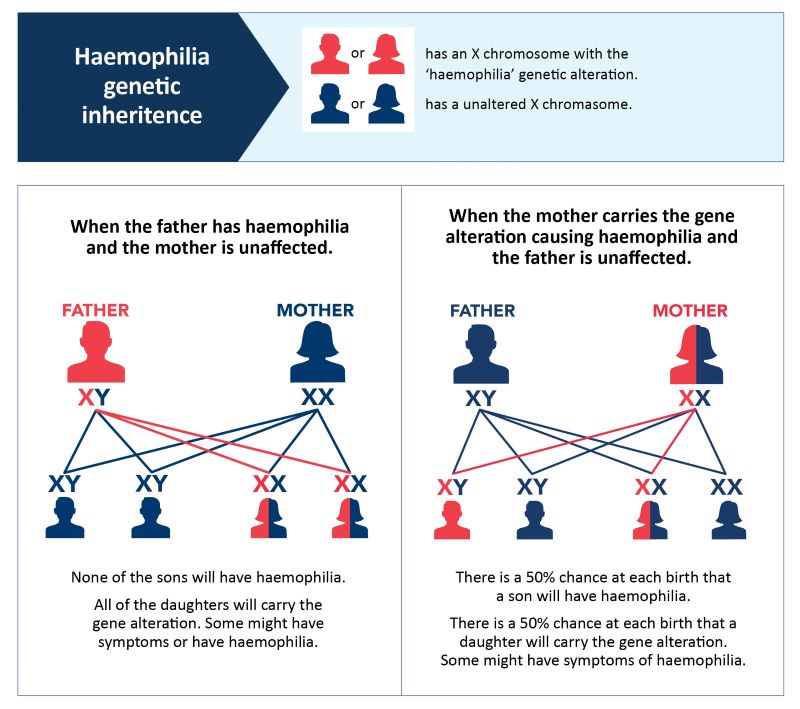KARA CORDINER, PENNY MCCARTHY AND MEGAN WALSH
Kara Cordiner, Penny McCarthy and Megan Walsh are Clinical Nurse Consultants at the Ronald Sawers Haemophilia Centre, The Alfred hospital, Melbourne.
When men with haemophilia call us at the Haemophilia Treatment Centre asking when to get their daughters tested to see if they carry the gene alteration for haemophilia, they are often surprised to hear that all their daughters are ‘haemophilia carriers’.
While our male patients with haemophilia usually understand their condition and manage it well, they sometimes do not fully understand the inheritance pattern in their family. Haemophilia genetics are complex and it can be challenging to appreciate the implications of heredity – that it is a multigenerational health condition that can affect your extended family, as well as family members close to you.
Haemophilia is often not a ‘dinner table’ discussion within the family, where inheritance and who is affected could be explored. As a result, family members can be unaware they are affected until an issue occurs.

Haemophilia is caused by a mutation or alteration in the gene making clotting factor VIII (8) or clotting factor IX (9).
In genetics:
The genes for making factor VIII (8) and IX (9) are located on the X chromosome.
Everyone is born with ‘sex’ chromosomes. The X and Y sex chromosomes help to determine haemophilia inheritance patterns.
How do children inherit X and Y sex chromosomes from their parents?
Any male or female with an alteration in their F8 or F9 gene can pass it on to their children during reproduction, when X chromosomes are passed on from parent to child.

If a male with haemophilia has children, he will pass his X chromosome onto all his daughters and they will inherit the gene alteration from him.
None of his sons will have haemophilia – they receive their X chromosome from their mother, who is usually unaffected.
Females can carry the gene alteration causing haemophilia even if they don’t have symptoms.
A woman who carries the gene alteration can pass it on to both her sons and her daughters as all of her children will receive one of her X chromosomes.
It is helpful to remember that genetics does not have a memory. With each pregnancy:
This information explains the typical experience of genetic inheritance in haemophilia, but it can be more complex in some individuals. Gender affirming medical care after birth, eg hormones or surgery that some trans or gender diverse people may use to affirm their gender, will not change a person’s sex chromosomes or influence haemophilia inheritance patterns.
Their Haemophilia Treatment Centre can support gender diverse people with haemophilia with help to understand their individual bleeding and inheritance patterns and refer them to other genetic specialists, if appropriate.



The most frequently asked questions we hear are:
Our advice:

Many men don’t know that their son will not be affected by haemophilia and their sons will not pass on the gene either.
Their daughters will always carry the gene alteration. Some may be asymptomatic with normal factor levels while others can have low factor levels and be considered to have mild haemophilia. Their father’s severity level does not determine their daughters’ levels and it is very rare for a female to have moderate or severe haemophilia.
Regardless of their own factor levels, daughters of men with haemophilia have a 50% chance of having a son with haemophilia and 50% chance of having a daughter that carries the ‘haemophilia’ gene alteration with each pregnancy.
Sometimes your inheritance pattern means you must have the gene alteration. In genetics this is called being an obligate carrier.
Obligate haemophilia carriers include:
Parents are often confused about where to seek guidance and what to do if a man with haemophilia has a daughter.
There is usually no rush to perform factor level testing when she is a small child unless she is symptomatic or if there is a need for surgery. However, it is recommended that she has factor level testing before she starts menstruating (getting her period) in case she will need a treatment plan for managing heavy periods.

If the family mutation is not known, fathers should consider having a genetic mutation test, which identifies the haemophilia genetic mutation in their family. This is valuable in several ways:
It is helpful if females in the family understand if they are at risk of being haemophilia carriers. It is also important for them to know other information:
Genetic testing is much quicker and easier if the family mutation is known. It can take many months to get a result with new genetic mutation testing. It is valuable for women to have had genetic testing and know their results before getting pregnant.

Family trees are crucial for providing information for families when speaking about haemophilia and how it is passed on. As haemophilia is X-linked, it may affect many different branches of the family where there are many different surnames. We often find that someone in the family is the family tree keeper and their assistance is invaluable in identifying who is affected.
If a man with haemophilia has daughters, it is important to speaking to them about being a carrier before they reach childbearing age.
As they grow up, this can involve making sure they understand what being a carrier means and making the information about haemophilia in the family accessible.
Information about the family gene mutation includes not only what it is, but who in the family has done the testing and through which Haemophilia Treatment Centre so that records can be accessed to match when daughters need to have genetic testing and/or are undertaking family planning.
Daughters also need to know they should share this information with their obstetrician. This information allows daughters to have a have safe pregnancy and their babies a safe delivery.
Many people find genetic testing gives them a lot to think about. Their local Haemophilia Treatment Centre will be able to support daughters and their partners in these discussions around haemophilia inheritance and testing: they may have genetic counsellors on site who are able to assist with these discussions or they can refer the daughter and her partner to external genetic counsellors. The Haemophilia Treatment Centre can also refer to other counselling services, if needed; or alternatively their daughter can seek a referral through her GP.
Speak to your Haemophilia Treatment Centre for more information on haemophilia inheritance and genetic testing.
Read more in Haemophilia testing in women and girls: a guide (Haemophilia Foundation Australia, 2023)
Haemophilia Foundation Australia acknowledges the Traditional Owners and Custodians of Country throughout Australia, the land, waters and community where we walk, live, meet and work. We pay our respects to Elders past and present and extend that respect to all Aboriginal and Torres Strait Islander peoples.
Sign up for the latest news, events and our free National Haemophilia magazine